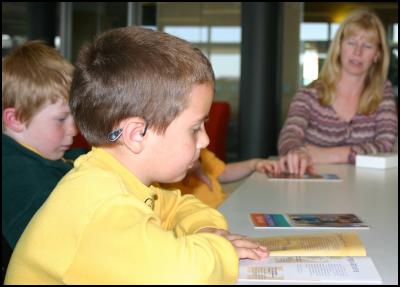Radio earphones help kids w reading difficulties
Monday, 5 September 2005, 3:03 pm
Press Release: Auckland University

Click for big version
A child uses the FM radio earphones.
Media Release
5 September 2005
Radio earphones help children with reading difficulties
A study by researchers based at The University of Auckland has found children with reading difficulties can perform much better in the classroom when equipped with tiny FM radio earphones.
The study by Associate Professor Suzanne Purdy, head of Speech Science and research fellow Dr Mridula Sharma, both of the Department of Psychology, and Phonak research audiologist Melissa Caldwell, investigated the effectiveness of personal FM radio earphones in the classroom with a group of South Auckland school children.
The children in the study all had difficulties learning to read and are significantly behind in their reading age based on school test results.
Forty-six children from the South Auckland school took part in the study - half were given the radio earphones - and their classroom behaviour and listening skills were monitored over a six-week period.
Associate Professor Purdy says they were pleasantly surprised at the results which showed significant improvements in the listening skills of children with the radio earphones.
“The teachers also reported the children were staying focussed, concentrating for longer, and asking better questions. We would now like to do some more trials with this school for a longer period.”
Advertisement - scroll to continue reading
Associate Professor Purdy says many children with learning difficulties have poor auditory processing.
“Auditory processing disorder (APD) is a condition where the ears hear but the brain can’t process what is heard effectively. APD can cause speech and language problems, reading difficulties and dyslexia in children, and is also found in children with attention deficit disorders.
“For these children, today’s noisy classrooms are the worst possible learning environment – they have difficulty listening when there is lots of background noise,” she says.
The tiny FM radio earphones sit behind the student’s ear, and the teacher wears a small microphone and transmitter. The FM earphones allow the student to hear the teacher more clearly, and filter out other classroom noise.
The FM device also ensures the teacher is heard clearly when the classroom has poor acoustics or when the teacher is at some distance from the student.
While the study was not long enough to identify whether there was a significant improvement in reading as a result of the FM trial, Melissa Caldwell says reading results supplied by the school for the 6-month period before and after the FM trial show an encouraging trend towards improved reading scores for the children who wore the FM radio earphones, compared to the children in the control group who did not wear the FM.
ENDS
Advertisement - scroll to continue reading
a.supporter:hover {background:#EC4438!important;} @media screen and (max-width: 480px) { #byline-block div.byline-block {padding-right:16px;}}
Using Scoop for work?
Scoop is free for personal use, but you’ll need a licence for work use. This is part of our Ethical Paywall and how we fund Scoop. Join today with plans starting from less than $3 per week, plus gain access to exclusive Pro features.
Join Pro Individual Find out more
Find more from Auckland University on InfoPages.